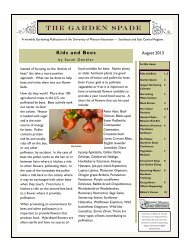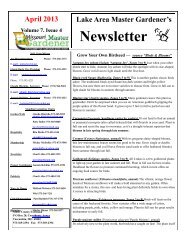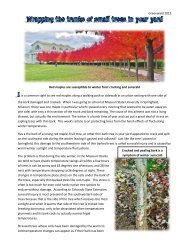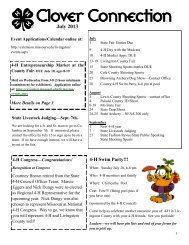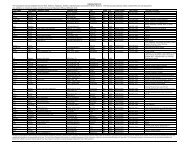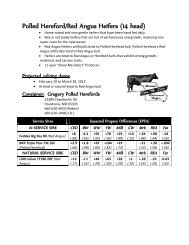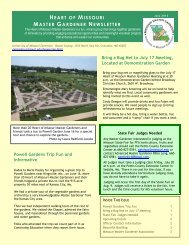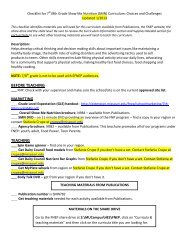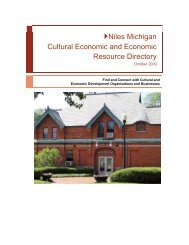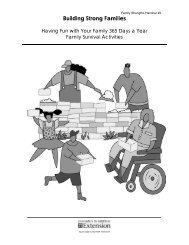Artificial Insemination in Beef Cattle - University of Missouri Extension
Artificial Insemination in Beef Cattle - University of Missouri Extension
Artificial Insemination in Beef Cattle - University of Missouri Extension
You also want an ePaper? Increase the reach of your titles
YUMPU automatically turns print PDFs into web optimized ePapers that Google loves.
<strong>Artificial</strong> <strong>Insem<strong>in</strong>ation</strong> <strong>in</strong><br />
<strong>Beef</strong> <strong>Cattle</strong><br />
Advanc<strong>in</strong>g the quality <strong>of</strong> the herd.<br />
Lynn Searcy
Steps <strong>in</strong>volved <strong>in</strong> AI<br />
Selection <strong>of</strong> the bulls<br />
Tools used<br />
Facilities<br />
Heat detection and<br />
tim<strong>in</strong>g<br />
Handl<strong>in</strong>g <strong>of</strong> the<br />
Semen<br />
<strong>Insem<strong>in</strong>ation</strong>
Bull selection<br />
AI allows for an enormous range <strong>of</strong> options <strong>in</strong><br />
the bulls that you use.<br />
Bulls are listed <strong>in</strong> catalogs and their pedigree<br />
and EPDs are provided to help with the<br />
selection.
EPD<br />
Expected Progeny Differences<br />
These are used to estimate how<br />
future progeny <strong>of</strong> an animal will<br />
compare to progeny <strong>of</strong> other<br />
animals with<strong>in</strong> the breed.
EPDs account for:<br />
Genetic value <strong>of</strong> cows to which the bull is<br />
bred.<br />
Environmental differences affect<strong>in</strong>g<br />
contemporary groups.<br />
Genetic differences <strong>of</strong> other parents <strong>in</strong> the<br />
contemporary group.<br />
Genetic trend.
EPDs and Accuracy<br />
Accuracy is the reliability <strong>of</strong> the EPD<br />
numbers.<br />
Low: 0.0 to .25<br />
Medium: .25 to .50<br />
High: .50 to 1.0
EPD example<br />
G A R Grid Maker<br />
Production<br />
Birth Wean Milk Herds Year Yr Ht Mwt Mht Scr<br />
Acc Acc Acc Daus Acc Acc Acc Acc Acc<br />
5.8 65 24 6 119 0.6 I -2 I +.5 0.17<br />
0.99 0.99 0.74 15 0.98 0.98 0.25 0.27 0.99<br />
Carcass Ultrasound Body Composition<br />
Cwt Mrb RE Fat %RP Grp %IMF RE Fat %RP Grp<br />
Acc Acc Acc Acc Acc Prog Acc Acc Acc Acc Prog<br />
38 -0.1 0.91 -0.015 0.79 8 -0.03 0.81 -0 0.56 168<br />
0.88 0.9 0.88 0.86 0.87 44 0.85 0.85 0.85 0.85 463
Liquid Nitrogen tank<br />
Long gloves<br />
<strong>Insem<strong>in</strong>ation</strong> rod<br />
Paper towels<br />
Straw cutter<br />
Sheath<br />
Tools used <strong>in</strong> AI<br />
Semen straw<br />
Warm water bath<br />
Thermometer<br />
Rubb<strong>in</strong>g alcohol<br />
Clock<br />
Record books
Proper work<strong>in</strong>g<br />
facilities are a must<br />
when AI-<strong>in</strong>g cattle.<br />
It eases stress and<br />
helps to prevent <strong>in</strong>jury<br />
<strong>of</strong> all <strong>in</strong>volved.<br />
Facilities
Heat detection<br />
This is the most limit<strong>in</strong>g factor <strong>in</strong> an AI<br />
program.<br />
The cow or heifer must be seen <strong>in</strong><br />
stand<strong>in</strong>g heat or active Estrus, this is<br />
<strong>in</strong>dicated by an altered behavior.<br />
The female that is <strong>in</strong> “heat” will become<br />
immobile when another animal, bull or<br />
cow, mounts her.
Heat detection and Tim<strong>in</strong>g<br />
Stand<strong>in</strong>g heat occurs every 18-24 days,<br />
and lasts for 10-14 hours.<br />
Tim<strong>in</strong>g is imperative when AI-<strong>in</strong>g a cow, to<br />
achieve the highest rate <strong>of</strong> conception, a<br />
cow seen stand<strong>in</strong>g <strong>in</strong> the am will be AI-ed<br />
<strong>in</strong> the pm, and if seen <strong>in</strong> the pm will be<br />
AI-ed <strong>in</strong> the am.<br />
This is done because the cow ovulates<br />
after stand<strong>in</strong>g heat.
Handl<strong>in</strong>g <strong>of</strong> the semen<br />
Semen is stored <strong>in</strong> a plastic straw<br />
Straws are stored <strong>in</strong>side <strong>of</strong> a cane.<br />
Canes are suspended <strong>in</strong> a canister which<br />
is <strong>in</strong>side the liquid nitrogen tank.<br />
The liquid nitrogen keeps the temperature<br />
<strong>of</strong> the semen at -320F
Handl<strong>in</strong>g <strong>of</strong> the semen<br />
When prepar<strong>in</strong>g the semen for AI-<strong>in</strong>g a cow, the<br />
canister is lifted to the neck <strong>of</strong> the liquid nitrogen<br />
tank the selected cane is lifted and a straw is<br />
removed with<strong>in</strong> 10 seconds.<br />
The straw is pulled from the cane and deposited<br />
<strong>in</strong>to the warm water bath that is 90-98 degrees,<br />
and left for 45 to 60 seconds.<br />
It is then wrapped <strong>in</strong> a paper towel and shaken<br />
so the sperm is on one end and an air bubble is<br />
at the other.
Handl<strong>in</strong>g <strong>of</strong> the semen<br />
The straw cutter is then used to make a square<br />
cut end on the straw which is then fitted <strong>in</strong>to the<br />
sheath.<br />
The sheath is then fitted onto the <strong>in</strong>sem<strong>in</strong>ation<br />
rod.<br />
The <strong>in</strong>sem<strong>in</strong>ation rod is then tucked <strong>in</strong>to the AIer’s<br />
cloth<strong>in</strong>g for transport to the cow.<br />
<strong>Insem<strong>in</strong>ation</strong> <strong>of</strong> the cow should occur with<strong>in</strong><br />
m<strong>in</strong>utes <strong>of</strong> the semen be<strong>in</strong>g thawed.<br />
This should not exceed 15 m<strong>in</strong>utes.
<strong>Insem<strong>in</strong>ation</strong> process<br />
The outside <strong>of</strong> the cow’s reproductive tract<br />
should be wash before <strong>in</strong>sem<strong>in</strong>ation.<br />
This prevents the <strong>in</strong>troduction <strong>of</strong> manure and<br />
other contam<strong>in</strong>ants to the reproductive tract.<br />
The gloved arm is <strong>in</strong>serted <strong>in</strong>to the rectum and<br />
the cervix grasped.<br />
The <strong>in</strong>sem<strong>in</strong>ation rod is then <strong>in</strong>troduced <strong>in</strong>to the<br />
vag<strong>in</strong>a and passed through the cervix <strong>in</strong>to the<br />
uterus.
<strong>Insem<strong>in</strong>ation</strong><br />
<strong>Artificial</strong> <strong>in</strong>sem<strong>in</strong>ation technique <strong>in</strong> the cow. PL Senger. 2003.<br />
Pathways to Pregnancy and Parturition. Fig. 12.6, Page 274.



